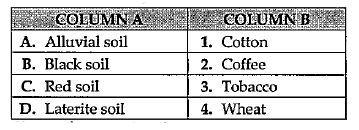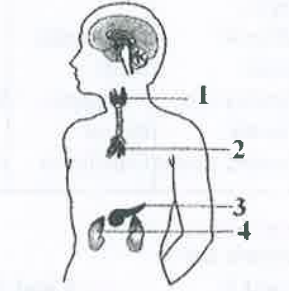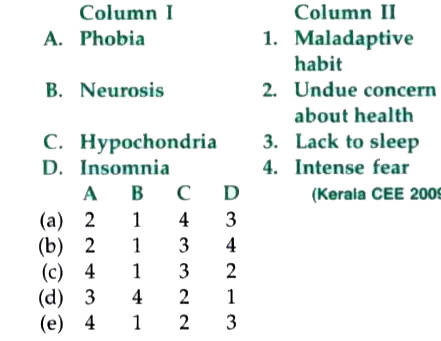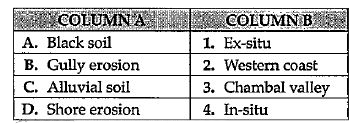Choose the correct match.
LH - Corpus luteum
Estrogen - Ovarian follicle
Progesterone - Zona pellucida
FSH - Ovary
The correct Answer is:B
To solve the question of choosing the correct match, we will analyze each option provided and determine whether the pair is correctly matched based on biological functions and relationships.
1. Analyze Option 1: LH and Corpus Luteum
- Luteinizing Hormone (LH) is produced by the anterior pituitary gland and stimulates the ovaries.
- The corpus luteum is formed from the ruptured Graafian follicle and primarily secretes progesterone.
- There is no direct match between LH and the corpus luteum as LH does not produce or directly act upon the corpus luteum.
- Conclusion: This option is incorrect.
2. Analyze Option 2: Estrogen and Ovarian Follicle
- Ovarian follicles are responsible for the production of estrogen during the follicular phase of the menstrual cycle.
- Estrogen is indeed produced by the ovarian follicles, especially as they mature.
- This relationship is well-established in reproductive biology.
- Conclusion: This option is correct.
3. Analyze Option 3: Progesterone and Zona Pellucida
- The zona pellucida is a protective layer surrounding the ovum (egg) and does not produce hormones.
- Progesterone is produced by the corpus luteum and has no direct relationship with the zona pellucida.
- Conclusion: This option is incorrect.
4. Analyze Option 4: FSH and Ovary
- Follicle Stimulating Hormone (FSH) is produced by the anterior pituitary gland and stimulates the ovarian follicles to grow and mature.
- While FSH does play a role in the reproductive cycle, it does not directly produce estrogen or progesterone; it primarily stimulates the follicles.
- Thus, this option does not accurately represent a direct match.
- Conclusion: This option is incorrect.
Final Conclusion:
After analyzing all options, Option 2: Estrogen and Ovarian Follicle is the correct match.
---
- Luteinizing Hormone (LH) is produced by the anterior pituitary gland and stimulates the ovaries.
- The corpus luteum is formed from the ruptured Graafian follicle and primarily secretes progesterone.
- There is no direct match between LH and the corpus luteum as LH does not produce or directly act upon the corpus luteum.
- Conclusion: This option is incorrect.
- Ovarian follicles are responsible for the production of estrogen during the follicular phase of the menstrual cycle.
- Estrogen is indeed produced by the ovarian follicles, especially as they mature.
- This relationship is well-established in reproductive biology.
- Conclusion: This option is correct.
- The zona pellucida is a protective layer surrounding the ovum (egg) and does not produce hormones.
- Progesterone is produced by the corpus luteum and has no direct relationship with the zona pellucida.
- Conclusion: This option is incorrect.
- Follicle Stimulating Hormone (FSH) is produced by the anterior pituitary gland and stimulates the ovarian follicles to grow and mature.
- While FSH does play a role in the reproductive cycle, it does not directly produce estrogen or progesterone; it primarily stimulates the follicles.
- Thus, this option does not accurately represent a direct match.
- Conclusion: This option is incorrect.
After analyzing all options, Option 2: Estrogen and Ovarian Follicle is the correct match.
Topper's Solved these Questions
Similar Questions
Match the animals given in column A with their location in column B.
Column AColumn B(i)DodoA.Africa(ii)QuaggaB.Russia(iii)ThylacineC.Mauritius(iv)Stellar's sea cowD.Australia
Choose the correct match from the following.
View SolutionMatch the following list of animals with their level of organisation.
Division of LabourAnimalA.Organ leveli.PheretimaB.Cellular aggregate levelii.FasciolaC.Tissue leveliii.SpongillaD.Organ system leveliv.Obelia
Choose the correct match showing division of labour with animal example.
View Solution
Knowledge Check
Match the following list of animals with their level of organisation.
Division of LabourAnimalA.Organ leveli.PheretimaB.Cellular aggregate levelii.FasciolaC.Tissue leveliii.SpongillaD.Organ system leveliv.Obelia
Choose the correct match showing division of labour with animal example.A(i)-B, (ii)-C, (iii)-D and (iv)-AB(i)-B, (ii)-D, (iii)-C and (iv)-AC(i)-D, (ii)-A, (iii)-B and (iv)-CD(i)-A, (ii)-D, (iii)-C and (iv)-BChoose the correct option to match the following :
 A(A)-(iv),(B)-(i),(C )-(iii),(D)-(ii)B(A)-(ii), (B)-(i),(C )-(iv),(D)-(iii)C(A)-(iii),(B)-(i),(C )-(iv),(D)-(ii)D(A)-(iii),(B)-(i),(C )-(iv),(D)-(ii)
A(A)-(iv),(B)-(i),(C )-(iii),(D)-(ii)B(A)-(ii), (B)-(i),(C )-(iv),(D)-(iii)C(A)-(iii),(B)-(i),(C )-(iv),(D)-(ii)D(A)-(iii),(B)-(i),(C )-(iv),(D)-(ii)Match the following

Choose the correct option:AA-3, B-2, C-1, D-4BA-4, B-1, C-3, D-2CA-2, B-4, C-1, D-3DA-4, B-1, C-2, D-3
Given is the figure showing location of a few endocrine glands.

choose the one correct match
View SolutionChoose correct match
View SolutionChoose the option showing the correct match for work done by n moles of a diatomic ideal gas for change in temperature in different processes.

View SolutionMatch the following and choose the correct answer.

View SolutionMatch the following

Choose the correct option:
View Solution
